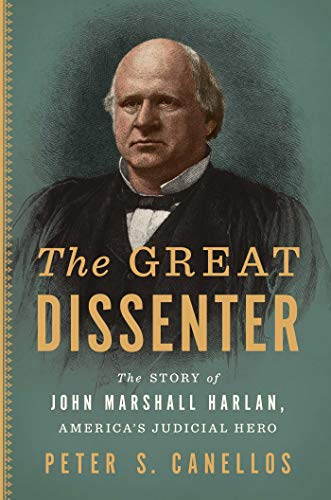
As we acknowledge Black History Month, we celebrate a 19th Century White man who was an impressive voice for racial equality. Described as the “Great Dissenter,” Justice John Marshall Harlan offered the lone, dissenting opinion in Plessy v. Ferguson (16 S.Ct. 1138, 1896), the Supreme Court case that approved separate but equal as a legal precedent and strengthened Jim Crow’s grip on American society.
Author Peter S. Canellos provides an enlightening and well-researched book about Justice John Marshall Harlan. Entitled The Great Dissenter: The Story of John Marshall Harlan, America’s Judicial Hero, this inspiring biography explains how and why Harlan became an advocate for color-blind justice. The focal point of the book is Harlan’s dissent in Plessy. The author details how Harlan stood passionately for equality even though his esteemed colleagues on the Supreme Court favored the entrenched, biased views of Jim Crow America.
Canellos describes Harlan’s early years, his political ventures, and his life as a justice. Harlan came from a family steeped in education and law. His father, James Harlan, was a lawyer who had the best law library in the state of Kentucky. He proudly named his son after Chief Justice John Marshall. However, more impactful than the name he was given was the relationship Harlan had with his adopted brother Robert Harlan, a bi-racial man who some thought to be the actual son of James Harlan. While Robert was a successful businessman, John Harlan witnessed a society that forced Robert and his family to flee to Britain to escape the racial injustices leading up to the Civil War.
Canellos describes Kentucky’s role in the Civil War, detailing the “armed neutrality” of the state against both Confederate and Union troops. Harlan supported Lincoln and fought with Sherman to defend Kentucky against Confederate attack. Harlan left the military to become Kentucky’s attorney general.
Appointed to the U.S. Supreme Court by President Rutherford B. Hayes, Justice Harlan grappled with cases that failed to enhance the equality that was promised by the post-war amendments. Justice Harlan surmised that the evolving legal system was “construed as to defeat the ends the people desired to accomplish, which they attempted to accomplish, and which they supposed they had accomplished by changes in fundamental law.” (p. 28)
Harlan’s uncompromising stand against inequality is depicted by his famous dissent in Plessy. Canellos describes the case and the surrounding events in a chapter entitled “The Humblest and Most Powerful.” The case involved the Louisiana “Separate Car Act,” and the defendant, Homer Plessy, carefully plotted the actions that led to his arrest for sitting in the whites-only part of the train. When the case went to the U.S. Supreme Court, all but one of the justices reasoned that those laws requiring racial separation were within Louisiana’s police power. In a heroic departure from his fellow justices, Harlan stood for Black rights and eloquently wrote in his dissent that:
“The white race deems itself to be the dominant race in this country. And so it is, in prestige, in achievements, in education, in wealth, and in power. So, I doubt not, it will continue to be for all time, if it remains true to its great heritage, and holds fast to the principles of constitutional liberty. But in view of the constitution, in the eye of the law, there is in this country no superior, dominant, ruling class of citizens. There is no caste here. Our constitution is color-blind, and neither knows nor tolerates classes among citizens. In respect of civil rights, all citizens are equal before the law. The humblest is the peer of the most powerful. The law regards man as man and takes no account of his surroundings or of his color when his civil rights as guaranteed by the supreme law of the land are involved. It is therefore to be regretted that this high tribunal, the final expositor of the fundamental law of the land, has reached the conclusion that it is competent for a state to regulate the enjoyment by citizens of their civil rights solely upon the basis of race.”
Justice Harlan served on the Supreme Court until his death in 1911. Well after his death, Justice Harlan’s legacy was influential in Brown v. Board of Education which excised “separate but equal” from the legal landscape. Thurgood Marshall, who argued the 1954 case, regarded Harlan’s dissent as the “bible” that he relied upon for attacking segregation. (p. 494) Harlan’s inspired defense of our color-blind constitution failed to inspire those in power at the end of the 19th century. However, the notion of a color-blind constitution is a simple but powerful message for all Americans, and his actions voicing that message are a compelling example today.
The book is available in the Ramsey County Law Library.
Peter S. Canellos, The Great Dissenter: The Story of John Marshall Harlan, America’s Judicial Hero. New York: Simon & Schuster, 2021.